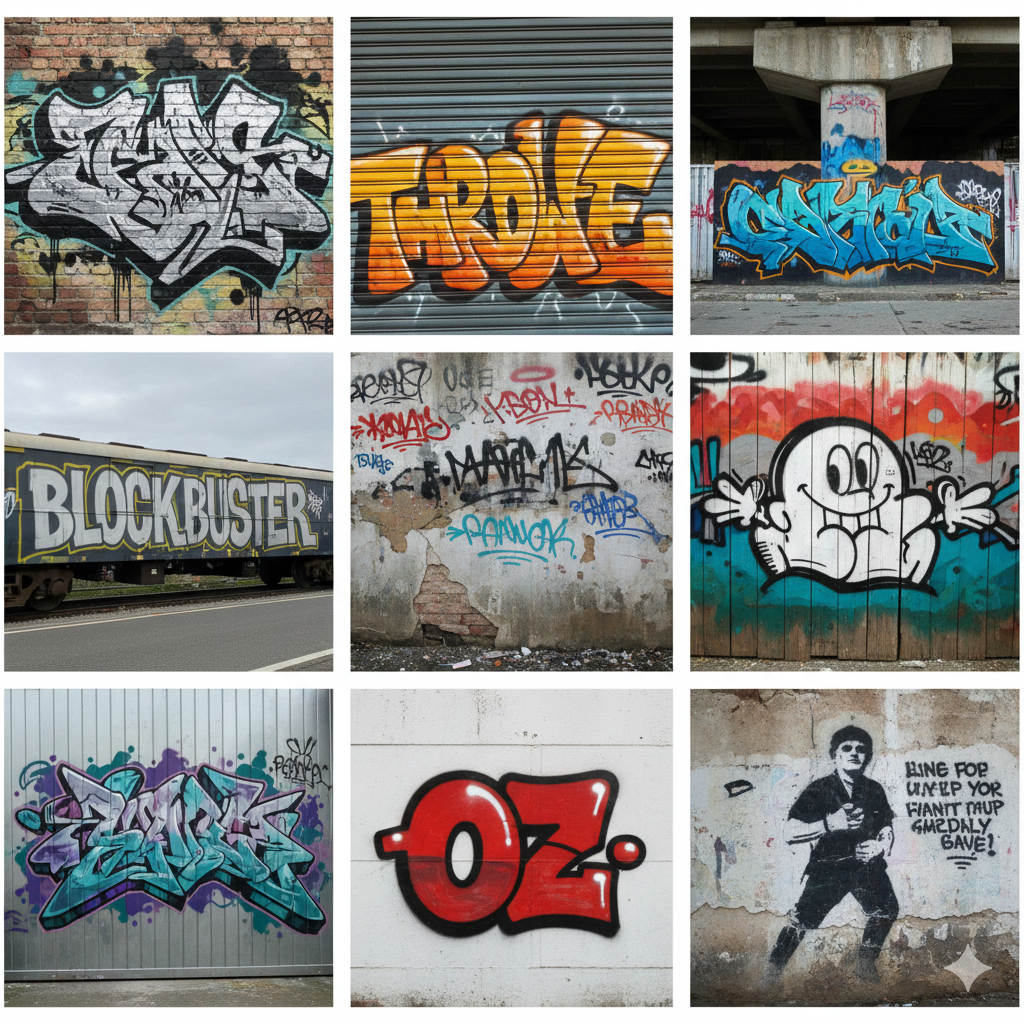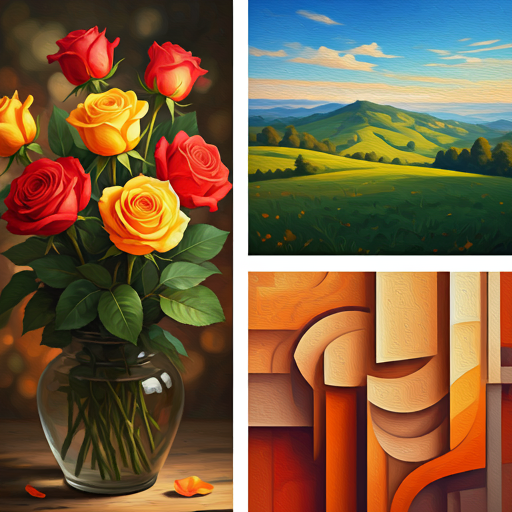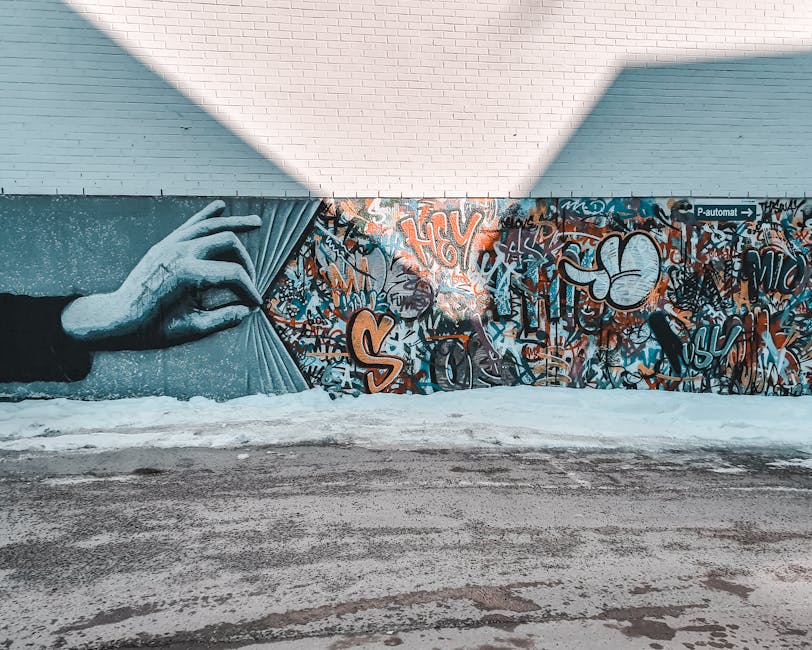
Imagine walking down a city street and seeing a vibrant, stylized word leaping out from a wall. That’s letter graffiti art. More than just scribbles, it’s a powerful form of self-expression, a visual language born from urban landscapes. For decades, artists have been transforming simple alphabets into dynamic, complex artworks, each letter telling a story. From the subway cars of New York City to gallery walls worldwide, letter graffiti art has evolved into a respected art form that combines technical skill, creative vision, and cultural significance.
Key Points:
- Letter graffiti art originated in late 1960s New York City as a form of urban self-expression
- Multiple distinct styles exist, from simple tags to complex Wildstyle lettering
- The art form has evolved from underground movement to mainstream recognition
- Mastering letter graffiti requires both artistic vision and technical precision
- Legal and ethical considerations are essential for aspiring graffiti artists
From Subways to Galleries: A Brief History of Letter Graffiti Art
Letter graffiti art burst onto the scene in the late 1960s and early 1970s, famously starting on the subway trains of New York City. Young artists, often called ‘writers,’ used spray paint to leave their ‘tags’ (stylized signatures) and ‘pieces’ (larger artworks) on trains, turning them into moving canvases. This was a way to gain recognition and express creativity in a city brimming with energy.
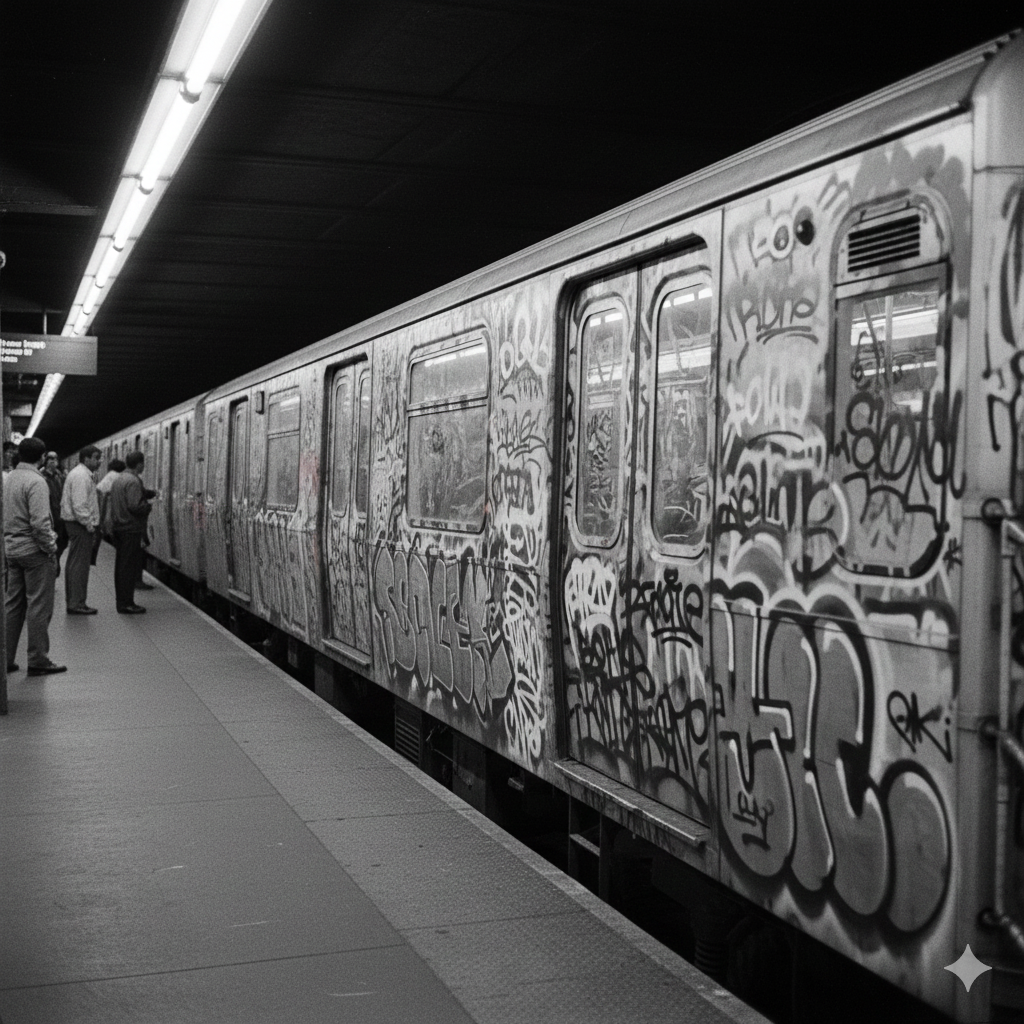
The movement’s roots trace back to hip-hop culture, where street artists developed their own visual language alongside rap music and breakdancing. Early pioneers like TAKI 183 and Tracy 168 established the foundation for what would become a global phenomenon. These writers weren’t just making marks—they were creating identities and claiming space in an urban environment that often overlooked marginalized voices.
Over time, letter graffiti evolved beyond simple tags. Artists developed complex styles like Wildstyle, characterized by intertwined letters, arrows, and spikes, making them almost unreadable to outsiders. What began as an underground movement quickly spread globally, influencing art, fashion, and hip-hop culture, eventually finding its way into art galleries and mainstream recognition. Today, artists like Banksy have elevated street art to fine art status, commanding millions at auction houses.
Comparing Popular Letter Graffiti Styles
A detailed comparison of common letter graffiti styles, highlighting their visual characteristics, level of complexity, and typical usage in the urban art scene.
| Style Name | Key Characteristics | Complexity Level | Common Usage |
|---|---|---|---|
| Tagging | Simple, stylized signature; often written quickly with markers or spray paint. | Low-Medium | Marking territory, quick recognition, personal signature. |
| Throw-ups | Bubble-like letters, often two-toned (outline and fill); quicker than a piece. | Medium | High visibility, rapid execution on walls or vehicles. |
| Wildstyle | Intricately interwoven letters, arrows, spikes, and connections; often difficult to read. | High | Showcasing skill, artistic expression, challenging the viewer. |
| Blockbuster | Large, bold, 3D-effect letters, often filled with vibrant colors; designed for maximum impact. | Medium-High | Filling large surfaces, high visibility, making a strong statement. |
| Bubble Letters | Soft, rounded, inflated-looking letters; often playful and easy to read. | Low-Medium | Beginner practice, friendly aesthetic, wide appeal. |
Understanding these different styles helps you appreciate the diversity within letter graffiti art. Each style serves a different purpose and requires unique skills. Bubble letters, for instance, are perfect for beginners learning painting techniques, while Wildstyle demands years of practice and deep understanding of letter construction.
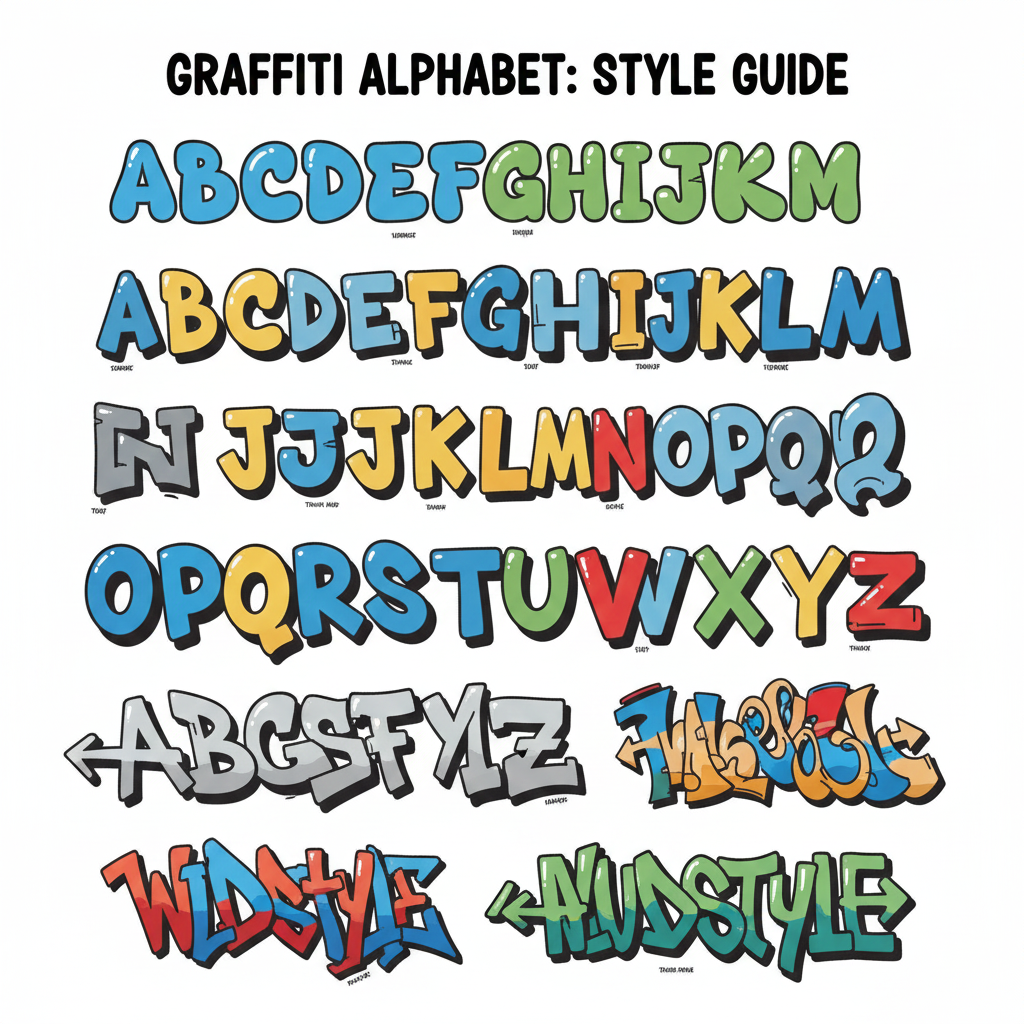
Understanding Letter Graffiti Art as a Form of Expression
Letter graffiti art represents more than decorative lettering—it’s a complete artistic movement with its own philosophy and cultural significance. As contemporary art continues to evolve, graffiti has secured its place as a legitimate form of creative expression.
The relationship between graffiti and traditional calligraphy is fascinating. Both art forms focus on the beauty and expressiveness of letterforms, though calligraphy follows more structured rules while graffiti embraces rebellion and innovation. Graffiti writers develop their own unique alphabets, treating each letter as a character with personality and attitude.
“Graffiti is one of the few tools you have if you have almost nothing. And even if you don’t come up with a picture to cure world poverty you can make someone smile while they’re having a piss.”
Banksy
The Tools of the Trade: Creating Masterful Letters
Behind every impressive graffiti letter art piece are specific tools and techniques. The most iconic tool is, of course, the spray can. Artists use different types of ‘caps’ (nozzles) to control the width and spray pattern of the paint, from thin lines for details to wide sprays for filling large areas. Markers, paint pens, and even regular pencils are also crucial for sketching ideas and adding finer details.
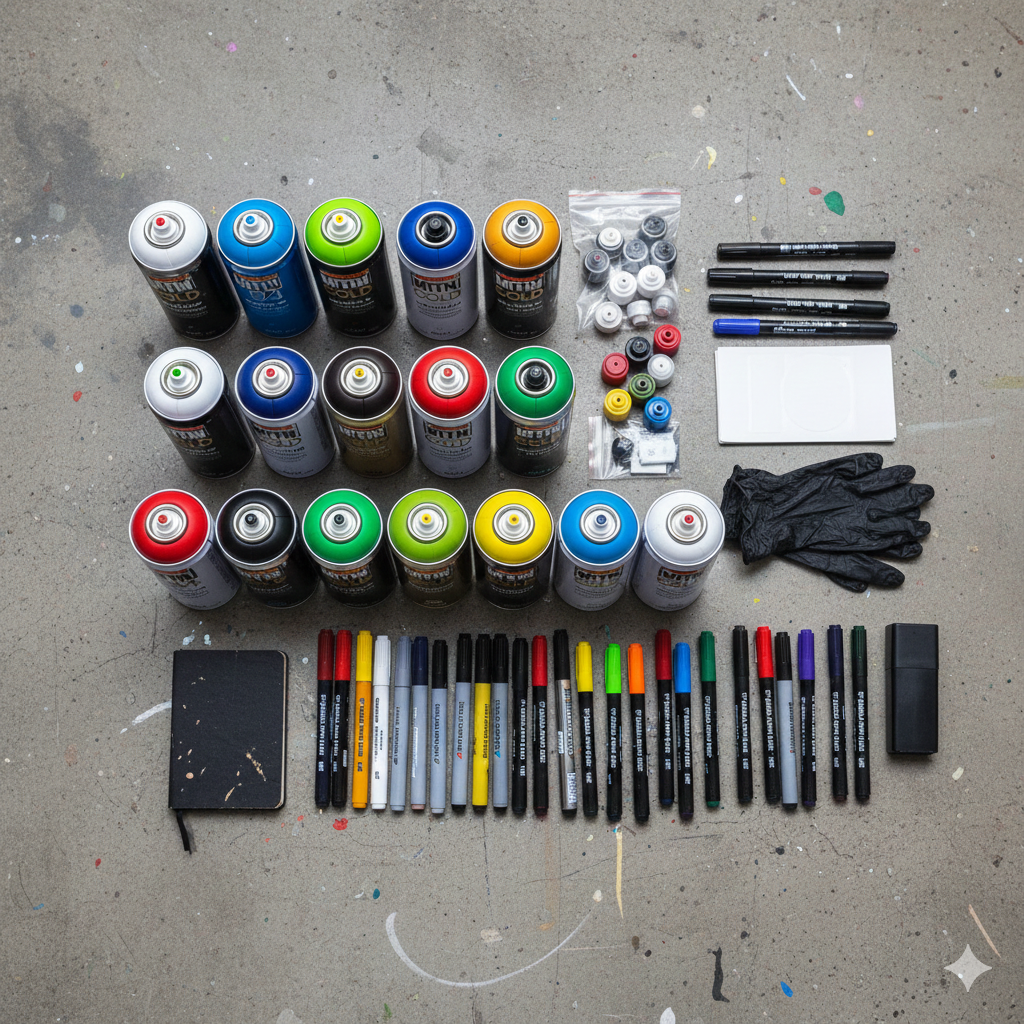
Understanding color theory is essential for graffiti artists. The vibrant palettes you see in successful pieces don’t happen by accident—artists carefully plan their color combinations to create maximum visual impact. Many graffiti writers start by developing their understanding of how to create mood with color choices before ever picking up a spray can.
But it’s not just about the tools; technique is key. Artists learn to control pressure, distance, and movement to achieve desired effects like clean outlines, smooth fills, and intricate fades. Mastering these skills takes hours of practice, dedication, and a deep understanding of how paint behaves on different surfaces. It’s a craft that combines artistic vision with technical precision.
Essential Graffiti Tools:
- Spray paint cans in various colors and quality grades
- Caps/nozzles (skinny, fat, soft, and specialty caps)
- Markers and paint pens for detail work and sketching
- Sketch books for planning designs and practicing letterforms
- Protective gear including masks, gloves, and appropriate clothing
- Quality primers for surface preparation
Similar to choosing the right canvas for traditional painting, selecting the right surface for graffiti affects the final result. Concrete, brick, metal, and wood each require different approaches and offer unique challenges.
Mastering Letter Design in Graffiti
Creating effective letter graffiti art requires understanding fundamental design principles. Composition plays a crucial role, determining how letters flow together and how the overall piece commands attention.
When designing letters, graffiti artists consider:
Letter Construction:
- Understanding basic letter anatomy (stems, crossbars, counters)
- Creating consistent weight and proportion across all letters
- Developing connections that make letters flow together naturally
- Adding style elements (arrows, spikes, extensions) that enhance rather than clutter
Visual Hierarchy:
- Using size variations to emphasize key letters or words
- Creating focal points through color contrasts and detail
- Balancing negative space with letterforms
- Considering how viewers’ eyes travel across the piece
Depth and Dimension:
- Adding shadows and highlights to create three-dimensional effects
- Using overlapping letters to suggest spatial relationships
- Implementing techniques for creating depth through color gradation
- Understanding how light interacts with forms
The complexity of letter graffiti art rivals many traditional art forms. Just as abstract artists use shapes and lines to convey meaning, graffiti writers manipulate letterforms to express identity, emotion, and cultural statements.
Tips for Aspiring Letter Graffiti Artists
If you’re inspired to try your hand at letter graffiti, here are essential tips to get started. First, begin with sketching on paper. Practice basic letter forms, like bubble letters, before moving to more complex styles. Study existing graffiti art to understand how letters connect and flow. Remember to develop your own unique style; that’s what makes graffiti truly personal.
Getting Started:

- Build a strong foundation by studying traditional lettering and typography
- Practice daily in your sketchbook—improving your art skills requires consistent effort
- Learn from masters by analyzing work from established graffiti artists
- Develop your hand control through repetitive exercises and drills
- Experiment with different tools to find what works best for your style
- Join the community by connecting with other artists and sharing your work
Starting your artistic journey can feel overwhelming, but beginners should focus on fundamentals first. Many successful graffiti artists began by simply practicing easy drawing exercises before developing their signature styles.
When you’re ready to use paint, always prioritize safety and legality. Find legal walls or practice spaces, wear appropriate protective gear like masks and gloves, and respect public and private property. Start with simple colors and gradually experiment with more complex palettes and techniques. Most importantly, have fun and let your creativity flow!
Safety and Legal Considerations:
- Always obtain permission before painting on any surface
- Wear proper respiratory protection when using spray paint
- Work in well-ventilated areas
- Research local laws regarding graffiti and public art
- Consider participating in legal graffiti jams and community mural projects
- Keep protective gear including gloves and eye protection
Organizing your painting tools becomes especially important for graffiti artists who often work quickly and need immediate access to materials.
The Cultural Impact of Letter Graffiti Art
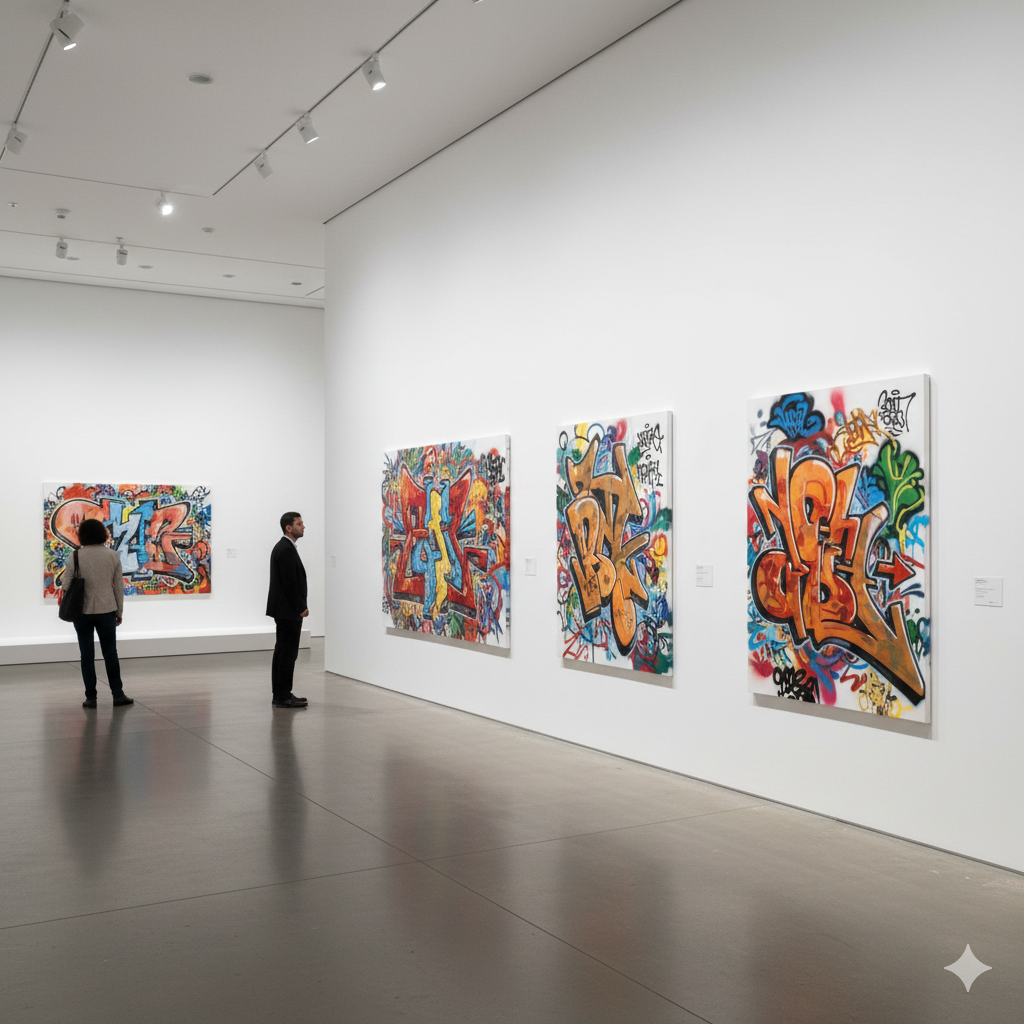
Letter graffiti art has profoundly influenced contemporary culture, extending far beyond painted walls. The aesthetic has permeated fashion, advertising, graphic design, and even digital media. Major brands regularly employ graffiti artists for campaigns, and street art has become a significant driver of local economies in many cities.
The relationship between graffiti and hip-hop culture remains strong. Both emerged from similar communities and shared a rebellious spirit that challenged mainstream culture. Together, they created a complete artistic movement that gave voice to urban youth worldwide.
Museums and galleries increasingly recognize graffiti’s artistic value. Major institutions like the Museum of Contemporary Art Los Angeles and the Brooklyn Museum have featured extensive graffiti exhibitions. Famous artists who started as graffiti writers have transitioned into fine art careers, commanding impressive prices for their work.
Educational institutions now offer courses in street art and graffiti, acknowledging its importance in art history and contemporary creative practice. This academic recognition represents a significant shift from graffiti’s outlaw origins.
Learning Resources for Letter Graffiti Art
YouTube Tutorial
Online Communities and Resources
Connecting with other artists accelerates your learning. Consider joining:
- Reddit communities like r/graffiti and r/Bombing for feedback and inspiration
- Instagram to follow established writers and discover new styles
- Local graffiti jams where artists gather to paint legally
- Online forums dedicated to discussing techniques and sharing knowledge
Many artists benefit from finding art inspiration through diverse sources. Social media has transformed how painters connect, making it easier than ever to learn from artists worldwide.
Books and Publications
Several excellent books cover graffiti history and technique:
- Subway Art by Martha Cooper and Henry Chalfant (the definitive photo documentation)
- The Art of Getting Over by Stephen Powers (insider’s guide to graffiti culture)
- Graffiti School by Christoph Ganter (practical instruction for beginners)
- Style Writing from the Underground by REAS and CANTWO (advanced technique guide)
Digital Letter Graffiti Art

The digital age has transformed how artists create and share letter graffiti art. Digital art tools allow artists to design pieces on tablets and computers, experimenting with unlimited colors and effects without using physical materials.
Popular digital tools for graffiti design include:
- Procreate for iPad users seeking intuitive drawing interfaces
- Adobe Illustrator for vector-based designs that scale infinitely
- Photoshop for photo-realistic digital graffiti mockups
- SketchBook offering free digital art software options for beginners
AI art generation tools have even entered the graffiti space, though they remain controversial among traditional writers who value hand-skills and authentic street culture. Understanding how AI is transforming the art world helps contextualize these developments.
Digital graffiti doesn’t replace traditional street art but offers additional creative possibilities. Many artists use digital tools for planning before executing physical pieces, or they create digital works for selling art online.
Letter Graffiti Art Tool
Graffiti Tool User Guide
This guide will walk you through using the Graffiti Studio application to create custom, street-art inspired designs.
1. Setting Up Your Text
The left sidebar contains all the controls for customizing your graffiti art.
| Control | Function | Instructions |
| Base Text | The text displayed in the center of the canvas. | Type your desired word or phrase (e.g., “STREET”, “DESIGN”). |
| Font Style | Selects the font for your text. | Choose from the dropdown list of high-impact fonts. You can also upload your own .ttf, .woff, or .otf file. |
| Size | Adjusts the height of the main text. | Use the slider to increase or decrease the text size. |
| Stroke | Adjusts the thickness of the black outline around the text. | Increase this value for a bolder, more classic graffiti look. |
| Colors (Gradient) | Sets the fill color(s) for the text. | Click the color swatches to pick two colors. Check the “Use Gradient Fill” box to blend them vertically. Uncheck it to use only the top color swatch for a solid fill. |
2. Customizing the Wall/Background
The background controls allow you to simulate different surfaces for your graffiti:
| Control | Function | Instructions |
| Procedural Texture | Selects a built-in background surface. | Choose from Concrete Wall, Brick Wall, Blueprint Grid, Dark Asphalt, or None (Transparent). |
| Choose Background Image | Uploads your own image file. | Click the button and select a JPG or PNG file from your computer. Then, select “Uploaded Image” from the dropdown menu above. |
| Global Lighting/Blend | Changes how the text interacts with the background. | Experiment with modes like Multiply (darkens the text onto the wall) or Overlay (gives the text a textured look) for a more realistic, integrated effect. |
3. Using the Tools & Effects
The tools section allows you to decorate your design using simulated brushes and stickers.
Tool Modes
| Tool | Icon | Function | Usage Instructions |
| Pointer | (Default) | Allows you to select and move stickers. | Click and Drag a sticker to reposition it. Hold Ctrl/Cmd while dragging horizontally to scale (resize) a sticker. |
| Spray Can | 🖌️ | Adds scattered dots for a spray paint effect. | Click and hold the mouse (or touch) on the canvas to draw. Adjust the Color, Size, and Flow (speed/density) in the settings panel below the buttons. |
| Drip Brush | 💧 | Adds realistic paint drips to the canvas. | Click once where you want the top of the drip to start. |
Drip Tool Options
- Drip Color: Sets the color for manual and automatic drips.
- Add Drips to Text: Automatically generates a random set of drips positioned underneath the main text block, simulating paint running down the wall.
- Clear: Removes all drips and spray paint marks from the canvas.
Stickers
- Click any of the Sticker buttons (e.g., Crown, Star, Splatter) to instantly add the graphic to the center of your design. Use the Pointer tool to move and scale them.
- Click Remove All Stickers to clear the sticker layer.
4. Exporting Your Design
Once you are satisfied with your creation, use the export buttons at the bottom of the sidebar:
- Save SVG: Downloads the design as a Scalable Vector Graphic file. This is useful for high-quality printing or further editing in vector programs.
- Save PNG: Downloads the design as a flat image file (Portable Network Graphic). This is ideal for sharing online or simple viewing.
Note: The background (wall texture) will be included in both the SVG and PNG exports if you have selected a background option other than “None.”
Conclusion
Letter graffiti art is far more than just writing on walls; it’s a vibrant, evolving art form with a rich history and a global presence. From its rebellious roots on subway trains to its recognition in contemporary art galleries, letter graffiti art continues to captivate and inspire. By understanding its styles, tools, and cultural significance, we can truly appreciate the skill and passion that goes into every dynamic letter. The journey from simple tags to complex pieces reflects not just artistic growth but the evolution of an entire cultural movement.
Whether you’re drawn to the bold simplicity of bubble letters or the intricate complexity of Wildstyle, letter graffiti art offers endless possibilities for creative expression. As you develop your skills—whether through traditional painting methods or digital tools—remember that authenticity and practice remain paramount. So next time you see a piece of letter graffiti art, take a moment to look closer—you might just decode a masterpiece that tells the story of an artist’s dedication, creativity, and vision.
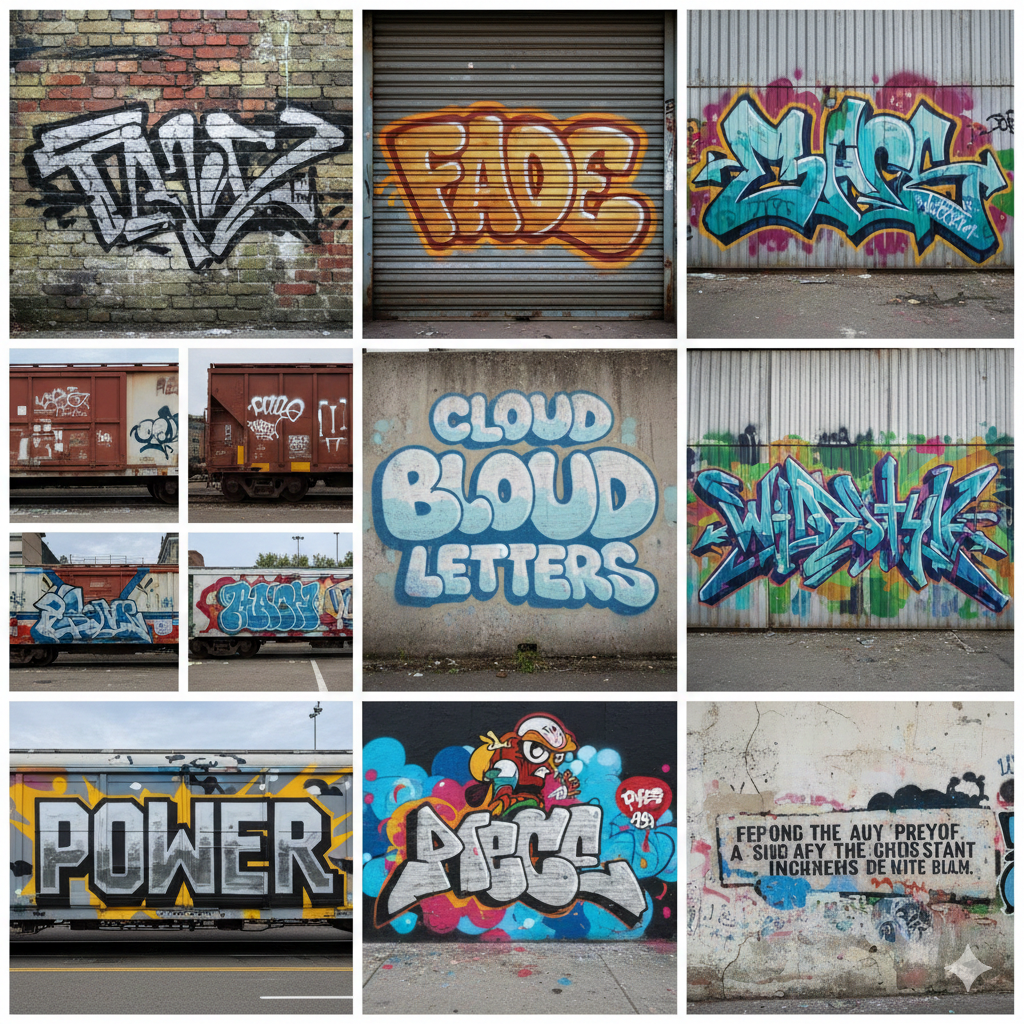
FAQs: Letter Graffiti Art
What is the difference between graffiti and street art?
Graffiti traditionally focuses on stylized lettering and tags, often done illicitly, stemming from a subculture with specific rules and hierarchies. Street art is a broader term encompassing various art forms including stencils, murals, sculptures, and installations created in public spaces. Street art often receives permission and can be more illustrative or conceptual, while traditional graffiti centers on letter-based work and writer recognition within the graffiti community.
Is letter graffiti art legal?
Legality depends entirely on where the art is created. If done on public or private property without permission, it is considered vandalism and is illegal in most jurisdictions, potentially resulting in fines or criminal charges. However, many cities have designated legal walls, commissioned murals, and community art programs where artists can create freely. Always obtain proper permission before painting, and seek out legal venues for practicing your craft.
What are the basic elements of a graffiti letter?
Basic elements include the ‘outline’ (the outer shape defining the letter), the ‘fill’ (the color inside), ‘highlights’ (light reflections that create depth), ‘shadows’ (darker areas for three-dimensional effect), and sometimes ‘connections’ or ‘extensions’ (decorative elements that link letters or extend from them). More advanced pieces may include ‘fades’ (gradual color transitions), ‘3D effects’ (exaggerated shadows creating depth), and various stylistic elements like arrows, spikes, and bubbles.
How can I learn to draw graffiti letters?
Start by practicing basic alphabet styles on paper, focusing on consistent letter height and width. Study examples online and attempt to replicate them to understand techniques. Focus on developing consistent letterforms before adding complex style elements. Progress from simple bubble letters to more elaborate styles like Wildstyle. Practice basic drawing fundamentals including proportion, perspective, and line control. Many online tutorials and books offer structured instruction. Consider joining local workshops or connecting with experienced writers who can provide mentorship.
What spray paint is best for graffiti letters?
Professional graffiti writers typically prefer brands like Montana, Ironlak, and Molotow for their quality, color range, and pressure consistency. These brands offer various lines designed specifically for graffiti, with high pigmentation and durable finishes. Beginners can start with hardware store brands like Rust-Oleum to practice basic techniques before investing in premium paint. The key factors are coverage, color vibrancy, and cap compatibility—quality paint accepts different cap types for varying line widths.
How long does it take to master graffiti lettering?
Mastering graffiti lettering varies by individual but typically requires years of consistent practice. Basic competency with simple styles might develop within 6-12 months of regular practice, but complex styles like Wildstyle often take 3-5 years or more to execute well. Like any art form, continuous improvement requires dedication, studying other artists’ work, receiving feedback, and constantly pushing creative boundaries. Most professional graffiti writers consider themselves perpetual students, always refining their craft.
Can graffiti letters be considered calligraphy?
While both graffiti and calligraphy involve stylized lettering, they represent distinct art forms with different histories, techniques, and cultural contexts. Calligraphy follows established traditions with specific tools and methods, emphasizing elegance and precision. Graffiti emerged from urban youth culture emphasizing individuality, rebellion, and style innovation. However, both share a fundamental appreciation for letterforms as art, and some contemporary artists blend elements of both disciplines.
How do I develop my own unique graffiti style?
Developing a unique style requires extensive practice and experimentation. Start by studying various graffiti styles and practicing different approaches. Incorporate elements you admire while avoiding direct copying. Experiment with letter proportions, connections, and decorative elements. Your style will naturally emerge through countless hours of sketching and painting. Focus on consistency—repeating similar elements across different pieces while gradually introducing innovations. Many artists find their style evolves continuously throughout their careers rather than being a fixed destination.
What role does letter graffiti play in hip-hop culture?
Letter graffiti is one of hip-hop’s foundational elements, alongside DJing, MCing, and breakdancing. Emerging simultaneously in 1970s New York City, graffiti provided visual representation for hip-hop culture. Writers documented the movement through tags and pieces while sharing hip-hop’s values of creativity, competition, and self-expression. Many early graffiti artists were also involved in other hip-hop disciplines, creating an interconnected cultural movement that transformed urban art worldwide.
How has social media changed graffiti culture?
Social media has dramatically transformed graffiti by allowing global visibility and instant sharing. Artists can build followings, sell work, and gain recognition without traditional gallery representation. However, social media also presents challenges—increased documentation can lead to legal issues, and the pressure to create “Instagram-worthy” work may influence artistic decisions. Platforms like Instagram have introduced graffiti to audiences who might never encounter it in person, expanding appreciation while potentially diluting the culture’s underground essence.
Citations:
- Gastman & Neelon. (2011). Available: Amazon – The History of American Graffiti
- Ganz, N. (2004). Graffiti World: Street Art from Five Continents. Available: Graffiti World
- Museum of the City of New York. (2014). City as Canvas: Graffiti Art from the Martin Wong Collection.

